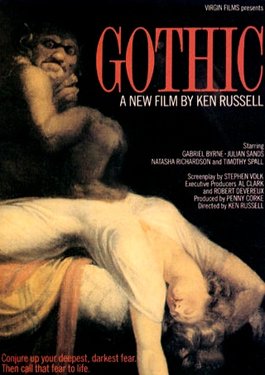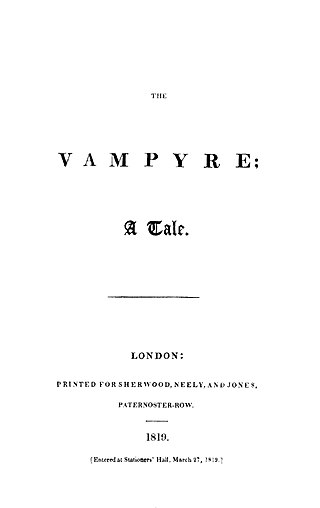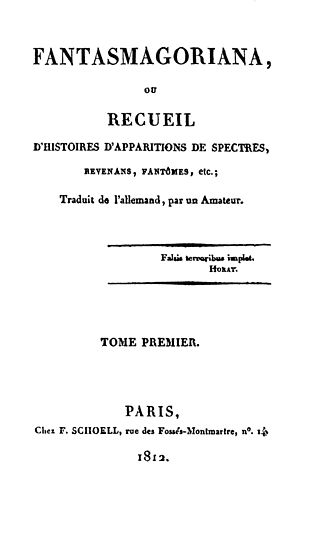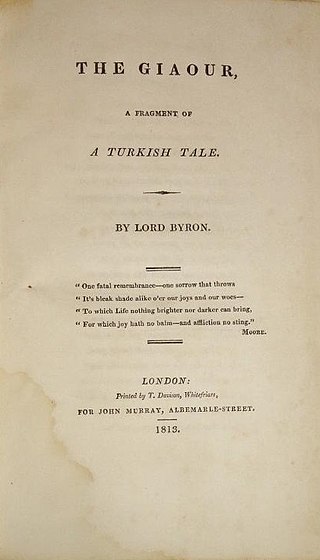
John William Polidori was a British writer and physician. He is known for his associations with the Romantic movement and credited by some as the creator of the vampire genre of fantasy fiction. His most successful work was the short story "The Vampyre" (1819), the first published modern vampire story. Although the story was at first erroneously credited to Lord Byron, both Byron and Polidori affirmed that the author was Polidori.

Vampire literature covers the spectrum of literary work concerned principally with the subject of vampires. The literary vampire first appeared in 18th-century poetry, before becoming one of the stock figures of gothic fiction with the publication of Polidori's The Vampyre (1819), which was inspired by the life and legend of Lord Byron. Later influential works include the penny dreadful Varney the Vampire (1847); Sheridan Le Fanu's tale of a lesbian vampire, Carmilla (1872), and the most well known: Bram Stoker's Dracula (1897). Some authors created a more "sympathetic vampire", with Varney being the first, and more recent examples such as Moto Hagio's series The Poe Clan (1972–1976) and Anne Rice's novel Interview with the Vampire (1976) proving influential.
This article contains information about the literary events and publications of 1819.

The Byronic hero is a variant of the Romantic hero as a type of character, named after the English Romantic poet Lord Byron. Both Byron's own persona as well as characters from his writings are considered to provide defining features to the character type.

Clara Mary Jane Clairmont, or Claire Clairmont as she was commonly known, was the stepsister of the writer Mary Shelley and the mother of Lord Byron's daughter Allegra. She is thought to be the subject of a poem by Percy Bysshe Shelley.

Gothic is a 1986 British psychological horror film directed by Ken Russell, starring Gabriel Byrne as Lord Byron, Julian Sands as Percy Bysshe Shelley, Natasha Richardson as Mary Shelley, Myriam Cyr as Claire Clairmont and Timothy Spall as Dr. John William Polidori. It features a soundtrack by Thomas Dolby, and marks Richardson's and Cyr's film debut.

"The Vampyre" is a short work of prose fiction written in 1819 by John William Polidori taken from the story Lord Byron told as part of a contest among Polidori, Mary Shelley, Lord Byron, and Percy Shelley. The same contest produced the novel Frankenstein; or, The Modern Prometheus. "The Vampyre" is often viewed as the progenitor of the romantic vampire genre of fantasy fiction. The work is described by Christopher Frayling as "the first story successfully to fuse the disparate elements of vampirism into a coherent literary genre."

Fantasmagoriana is a French anthology of German ghost stories, translated anonymously by Jean-Baptiste Benoît Eyriès and published in 1812. Most of the stories are from the first two volumes of Johann August Apel and Friedrich Laun's Gespensterbuch (1810–1811), with other stories by Johann Karl August Musäus and Heinrich Clauren.
Lord Ruthven is a fictional character. First appearing in print in 1819, in John William Polidori's "The Vampyre", he was one of the first vampires in English literature. The name Ruthven was taken from Lady Caroline Lamb's Glenarvon, where it was used as an unflattering parody of Lord Byron, while the character was based on Augustus Darvell from Byron's "Fragment of a Novel". "The Vampyre" was written privately, and published without Polidori's consent, with revisions to the story made by Polidori for an unpublished second edition showing that he planned to change the name from Ruthven to Strongmore. The initial popularity of "The Vampyre" led to the character appearing in many translations and adaptations, including plays and operas, and Ruthven has continued to appear in modern works. The Lord Ruthven Award (1989–present) by the Lord Ruthven Assembly is named after the character.

The Giaour is a poem by Lord Byron first published in 1813 by John Murray and printed by Thomas Davison. It was the first in the series of Byron's Oriental romances. The Giaour proved to be a great success when published, consolidating Byron's reputation critically and commercially.

Johann August Apel was a German writer and jurist. Apel was born and died in Leipzig.

The Villa Diodati is a mansion in the village of Cologny near Lake Geneva in Switzerland, notable because Lord Byron rented it and stayed there with Dr. John Polidori in the summer of 1816. Mary Shelley, Percy Bysshe Shelley, and Mary’s stepsister Claire Clairmont, who had rented a house nearby, were frequent visitors. Because of poor weather, in June 1816 the group famously spent three days together inside the house creating stories to tell each other, two of which were developed into landmark works of the Gothic horror genre: Frankenstein by Mary Shelley and The Vampyre, the first modern vampire story, by Polidori.

Mazeppa is a narrative poem written by the English Romantic poet Lord Byron in 1819. It is based on a popular legend about the early life of Ivan Mazepa (1639–1709), who later became Hetman of Ukraine. Byron's poem was immediately translated into French, where it inspired a series of works in various art forms. The cultural legacy of Mazeppa was revitalised with the independence of Ukraine in 1991.

George Gordon Byron, 6th Baron Byron was a British poet and peer. He is one of the major figures of the Romantic movement, and is regarded as being among the greatest of English poets. Among his best-known works are the lengthy narratives Don Juan and Childe Harold's Pilgrimage; much of his shorter lyrics in Hebrew Melodies also became popular.

Frankenstein; or, The Modern Prometheus is an 1818 novel written by English author Mary Shelley. Frankenstein tells the story of Victor Frankenstein, a young scientist who creates a sapient creature in an unorthodox scientific experiment. Shelley started writing the story when she was 18, and the first edition was published anonymously in London on 1 January 1818, when she was 20. Her name first appeared in the second edition, which was published in Paris in 1821.

Percy Bysshe Shelley was a British writer who is considered as one of the major English Romantic poets. A radical in his poetry as well as in his political and social views, Shelley did not achieve fame during his lifetime, but recognition of his achievements in poetry grew steadily following his death, and he became an important influence on subsequent generations of poets, including Robert Browning, Algernon Charles Swinburne, Thomas Hardy, and W. B. Yeats. American literary critic Harold Bloom describes him as "a superb craftsman, a lyric poet without rival, and surely one of the most advanced sceptical intellects ever to write a poem."

Rowing with the Wind a.k.a. Remando al viento is a 1988 Spanish film written and directed by Gonzalo Suárez. The film won seven Goya Awards. It concerns the English writer Mary Shelley and her circle.
English writer Lord Byron has been mentioned in numerous media. A few examples of his appearances in literature, film, music, television and theatre are listed below.
The Vampire, formally known as The Vampire; or, The Bride of the Isles, is a play written by James Robinson Planché. It was premiered on the London stage in 1820 as the first appearance of the vampire as an image of sophistication and nobility.

The Black Vampyre; A Legend of St. Domingo is an American short story published in 1819 by the pseudonymous Uriah Derick D'Arcy. It is credited as "the first black vampire story, the first comedic vampire story, the first story to include a mulatto vampire, the first vampire story by an American author, and perhaps the first anti-slavery short story." The Black Vampyre tells the story of a black slave, who is resurrected as a vampire after being killed by his captor; the slave seeks revenge on his captor and achieves it by stealing the captor's son and marrying the captor's wife. D'Arcy sets the story against the conditions that led to the Haitian Revolution.


















